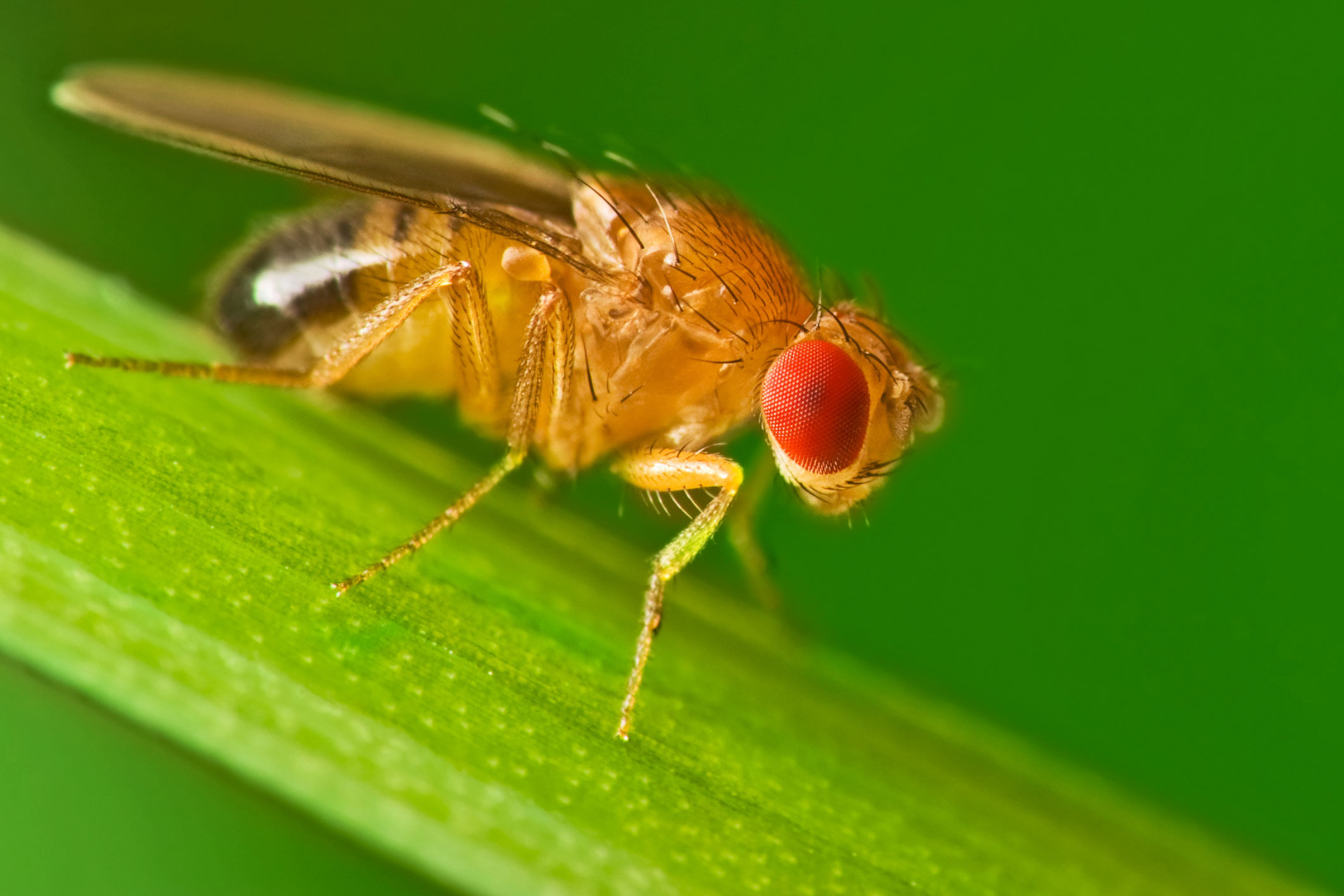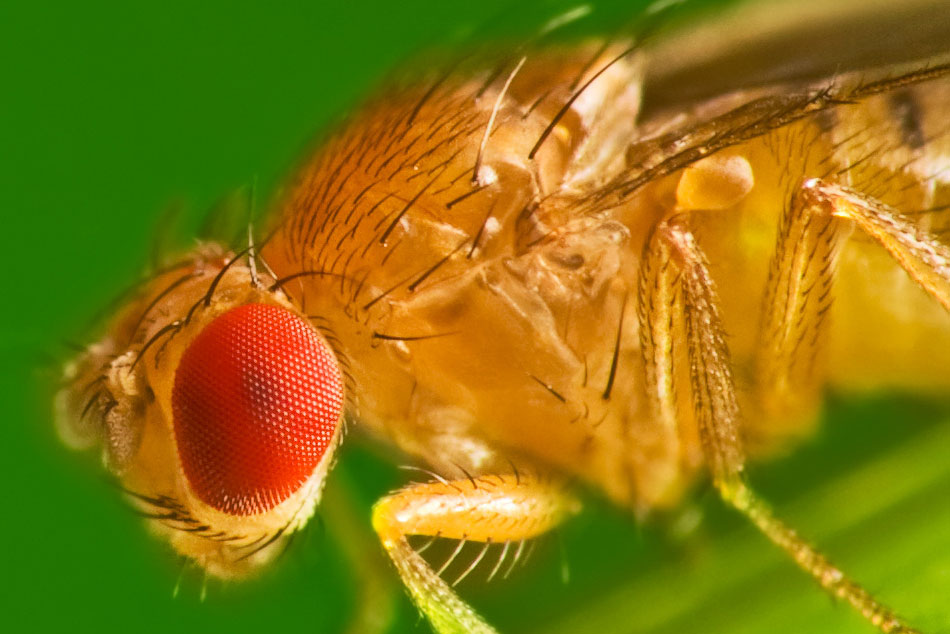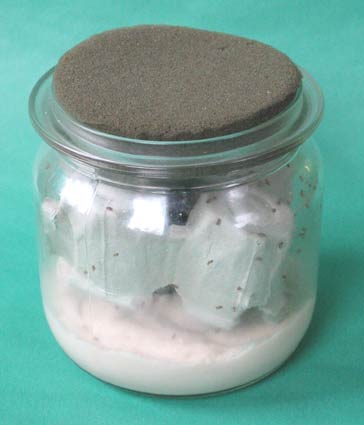Drosophila sp. / Fruit Fly
The fruit fly or vinegar fly is an excellent feeder for many tropical fish species. Both the imagines and the larvae are eaten readily and willingly, and some surface fish cannot be kept healthy or even reproduce without such “approach food”. But it is also a welcome addition to the usual diet for other fish.
Different fruit flies
When people talk about “the” fruit fly, they usually have the species Drosophila melanogaster (“small flies”) in mind, as they are always found in the vicinity of (over)ripe fruit in summer. However, other species, such as D. hydei (“large flies”) are also well suited for reproduction, even if their breeding is not quite as productive and fast as that of D. melanogaster.


Biology
D. melanogaster females lay the eggs directly on the culture medium. The first larvae hatch after about 24 hours. They feed mainly on microorganisms such as yeasts. Within the next 10 days, the larvae moult three times and then pupate. After 4 - 5 days the imagines (full insects) hatch, they immediately begin to copulate and lay eggs again on the third day of life. Most eggs are produced from the third to the sixth day of life. Some species such as D. melanogaster can spend their entire life cycle in the dark, others such as D. subobscura only copulate in the light. As you don't usually know exactly which species are being kept, you may have to experiment a little. I keep my starters in the living room on a pedestal next to the aquarium.
The reproduction cycle of the D. hydei is considerably longer than that of their smaller cousins; in return, the service life of the preparations is considerably longer if evaporated water is topped up from time to time. They are naturally more suitable for larger fish because they are also much more “fidgety” than the “little ones”, so that they are accepted even better by hesitant fish.
The best reproduction results can be achieved at temperatures of 20 - 23 °C. This is also the ideal temperature for D. hydei, which apparently stops laying eggs above 25 °C. The development of the other species is fastest at 24 - 26 °C.

Recipes
There are certainly almost as many working recipes for breeding Drosophila as there are aquarists who breed live food at all. Nevertheless, we would like to briefly present our favourite recipes here in order to provide beginners in particular with a standard method that works well.
Suitable breeding containers are 1 litre preserving jars or other jars of an appropriate size, which can be sealed well with a double layer of gauze or, better still, with a piece of foam cut to size. If only one layer of gauze is used, wild Drosophila may mate with flies through the fabric. Suddenly you have a jar of flies ready to fly, which swarm through the flat the next time you open it.
Add a piece of egg carton or wood wool and 20 - 40 fruit flies (D. melanogaster, better more for D. hydei ) to the freshly prepared preparations.
After 1 - 2 weeks (3 - 4 weeks for D. hydei) you can already remove the first flies. If you add a little water or orange juice (evaporation) from time to time, you can remove flies for at least 4 - 5 weeks (10 weeks for D. hydei). Feeding is very convenient with the foam stopper. Take the foam stopper out of the jar and simply tap the flies sitting on it above the aquarium or carefully shake them out of the pouring opening.
Mites can occur as pests in Drosophila cultures. They are usually introduced by wild flies. Some species live parasitically on the flies, others live in the culture medium and compete with the larvae for food. Specific control agents are not known.
It helps to transfer the flies to new crops as often as possible until the cultures remain mite-free again.
Recipe 1
- 1 cube (40 g) fresh yeast
- 2 teaspoons household sugar
- 100 ml 5 - 6 % vinegar (or 20 - 23 ml vinegar essence (25 %), with water ad 100 ml)
- Cotton wool
- 10 drops of vitamin solution (not absolutely necessary)
Mix the yeast with 2 teaspoons of sugar until a thin paste is formed. Now add the vinegar and stir (the yeast-vinegar mixture has a pH of 3.1, but the pure vinegar has a pH of 2.5, i.e. the yeast buffers slightly). I add about 10 drops of a vitamin preparation (but it also works without). So much cotton wool is tamped into the mixture that no more liquid remains.
Even older preparations hardly smell at all.
Recipe 2
- 300 g soya meal
- 150 g rolled oats
- 40 g sugar
- 4 g salt
- 4 g dry yeast
- 1 pinch of methyl paraben on the surface
Pour orange juice (or another fruit juice) over the above mixture and leave to swell until you have a solid mass. If the mixture is still too liquid, stir in more material. You can then inoculate with flies. These preparations allow a very fast production of well-fed flies, but the preparations do not last very long; they should be prepared again after one generation cycle.
The considerable odour nuisance should not be underestimated.

